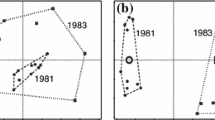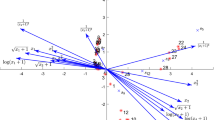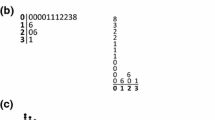Abstract
Canonical correspondence analysis (CCA) is a multivariate method to elucidate the relationships between biological assemblages of species and their environment. The method is designed to extract synthetic environmental gradients from ecological data-sets. The gradients are the basis for succinctly describing and visualizing the differential habitat preferences (niches) of taxavia an ordination diagram. Linear multivariate methods for relating two set of variables, such as two-block Partial Least Squares (PLS2), canonical correlation analysis and redundancy analysis, are less suited for this purpose because habitat preferences are often unimodal functions of habitat variables. After pointing out the key assumptions underlying CCA, the paper focuses on the interpretation of CCA ordination diagrams. Subsequently, some advanced uses, such as ranking environmental variables in importance and the statistical testing of effects are illustrated on a typical macroinvertebrate data-set. The paper closes with comparisons with correspondence analysis, discriminant analysis, PLS2 and co-inertia analysis. In an appendix a new method, named CCA-PLS, is proposed that combines the strong features of CCA and PLS2.
Similar content being viewed by others
References
Anderson, N. J., 1993. Natural versus anthropogenic change in lakes: the role of the sediment record. TREE 8:356–361.
Anderson, N. J., T. Korsman and I. Renberg, 1994. Spatial heterogeneity of diatom stratigraphy in varved and non-varved sediments of a small, boreal-forest lake. Aquat. Sci. 56:40–58.
Anderson, N. J., B. Rippey and C. E. Gibson, 1992. A comparison of sedimentary and diatominferred phosphorus profiles: implications for defining pre-disturbance nutrient conditions. Hydrobiologia 253:357–366.
Austin, M. P. and M. J. Gaywood, 1994. Current problems of environmental gradients and species response curves in relation to continuum theory. J. Veg. Sci. 5:473–482.
Austin, M. P., A. O. Nicholls, M. D. Doherty and J. A. Meyers, 1994. Determining species response functions to an environmental gradient by means of aβ-function. J. Veg. Sci. 5:215–228.
Bakker, C., P. M. J. Herman and M. Vink, 1990. Changes in seasonal succession of phytoplankton induced by the storm-surge barrier in the Oosterschelde (S. W. Netherlands). J. Plankton Res. 12:947–972.
Barker, P., 1994. Book review of “H. van Dam (Editor). Twelfth International Diatom Symposium. Kluwer, Academic Publ. Dordrecht”. Eur. J. Phycol. 29:281–283.
Birks, H. J. B., S. Juggins and J. M. Line, 1990a. Lake surface-water chemistry reconstructions from palaeolimnological data. In: Mason B. J. (ed.), The Surface Waters Acidification Programme, Cambridge University Press, Cambridge, pp. 301–313.
Birks H. J. B., J. M. Line, S. Juggins, A. C. Stevenson and C. J. F. ter Braak, 1990b. Diatoms and pH reconstruction. Phil. Trans. Roy. Soc. London, Ser B 327:263–278.
Birks, H. J. B., S. M. Peglar and H. A. Austin, 1994. An annotated bibliography of canonical correspondence analysis and related constrained ordination methods 1986–1993, Botanical Institute, Bergen, Norway, 58 pp.
Borcard, D., P. Legendre and P. Drapeau, 1992. Partialling out the spatial component of ecological variation. Ecology 73:1045–1055.
Carnes, B. A. and N. A. Slade, 1982. Some comments on niche analysis in canonical space. Ecology 63:888–893.
Carpenter, S. R., T. M. Frost and D. K. T. K. Heisey, 1989. Randomized intervention analysis and the interpretation of whole-ecosystem experiments. Ecology 70:1142–1152.
Charles, D. F. and J. P. Smol, 1994. Long-term chemical changes in lakes: quantitative inferences from biotic remains in the sediment record. In: Baker L. (ed.), Environmental Chemistry of Lakes and Reservoirs, American Chemical Society, Washington, pp. 3–31.
Chessel, D., J.-D. Lebreton and N. Yoccoz, 1987. Propriétés de l'analyse canonique des correspondances; une illustration en hydrobiologie. Rev. Statist. Appl. 35:55–72.
Copp, G. H., 1992. An empirical model for predicting microhabitat of 0+ juvenile fishes in a lowland river catchment. Oecologia 91:338–345.
Cumming, B. F., J. P. Smol and H. J. B. Birks, 1992. Scaled chrysophytes (Chrysophyceae and Synurophyceae) from Adirondack drainage lakes and their relationship to environmental variables. J. Phycol. 28:162–178.
de Jong, S. and R. W. Farebrother, 1994. Extending the relationship between ridge regression and continuum regression. Chemometrics Intell. Lab. Syst. 25:179–181.
de Jong, S. and C. J. F. ter Braak, 1994. Comments on the PLS kernel algorithm. J. Chemometrics 8:169–174.
Descy, J. P., 1979. A new approach to water quality estimation using diatoms. Nova Hedwigia, Beiheft 64:305–323.
Dolédec, S. and D. Chessel, 1994. Co-inertia analysis: an alternative method for studying speciesenvironment relationships. Freshwater Biol. 31:277–294.
Ellenberg, H., 1948. Unkrautgesellschaften als Mass für den Säuregrad, die Verdichtung und andere Eigenschaften des Ackerbodens. Ber. Landtech. 4:130–146.
Eriksson, L., J. L. M. Hermens, E. Johansson, H. J. M. Verhaar and S. Wold, 1995. Multivariate analysis of aquatic toxicity data. Aquat. Sci. this volume.
Escoufier, Y. and P. Roberts, 1979. Choosing variables and metrics by optimizing the RV-coefficient. In: Rustagi J. S. (ed.), Optimizing methods in Statistics, Academic Press, New York, pp. 205–219.
Fairchild, G. W. and J. W. Sherman, 1993. Algal periphyton response to acidity and nutrients in softwater lakes: lake comparison vs. nutrient enrichment approaches. J. N. Am. Benthol. Soc. 12:157–167.
Frank, I.E. and J. H. Friedman, 1993. A statistical view of some chemometric regression tools (with discussion). Technometrics 35:109–148.
Fritz, S. C., S. Juggins and R. W. Batterbee, 1993. Diatom assemblages and ionic characterization of lakes of the northern great plains, North America — a tool for reconstructing past salinity and climate fluctuations. Can. J. Fish. Aquat. Sci. 50:1844–1856.
Gabriel, K. R., 1982. Biplot. In: Kotz S. and N. L. Johnson (eds.), Encyclopedia of Statistical Sciences, Vol. 1, Wiley, New York, pp. 263–271.
Gabriel, K. R. and C. L. Odoroff, 1990. Biplots in biomedical research. Statist. Med. 9:469–485.
Gauch, H. G., 1982. Multivariate analysis in community ecology. Cambridge University Press, Cambridge, 298 pp.
Gause, G. F., 1930. Studies on the ecology of the Orthoptera. Ecology 11:307–325.
Geladi, P., 1988. Notes on the history and nature of partial least squares (PLS) modelling. J. Chemometrics 2:231–246.
Gower, A. M., G. Myers, M. Kent and M. E. Foulkes, 1994. Relationships between macroinvertebrate communities and environmental variables in metal-contaminated streams in south-west England. Freshwater Biol. 32:119–221.
Grantham, B. A. and B. J. Hann, 1994. Leeches (Annelida, Hirundinea) in the experimental lakes area, Northwestern Ontario, Canada — Patterns of species composition in relation to environment. Can. J. Fish. Aquat. Sci. 51:1600–1607.
Green, R. H., 1971. A multivariate statistical approach to the Hutchinsonian niche: bivalve mollucs of central Canada. Ecology 52:543–556.
Green, R. H., 1974. Multivariate niche analysis with temporally varying environmental factors. Ecology 55:73–83.
Green, R. H., 1979. Sampling design and statistical methods for environmental biologists. Wiley, New York, 257 pp.
Greenacre, M. J., 1984. Theory and applications of correspondence analysis, Academic Press, London, 364 pp.
Greenacre, M. J., 1989. The Carroll-Green-Schaffer scaling in correspondence analysis: a theoretical and empirical appraisal. J. Marketing Research 26:358–365.
Greenace, M. J., 1993. Biplots in correspondence analysis. J. Appl. Statist. 20:251–269.
Hawkes, H. A., 1975. River zonation and classification. In: Whitton B. A. (ed.), River Ecology. Studies in ecology, vol. 2, Univ. Calif. Press, pp. 312–374.
Heiser, W. J., 1987. Joint ordination of species and sites: the unfolding technique. In: Legendre P. and L. Legendre (eds.), Developments in numerical ecology. Springer-Verlag, Berlin, pp. 189–224.
Higler, L. W. G. and F. Repko, 1981. The effects of pollution in the drainage area of a Dutch lowland stream on fish and macro-invertebrates. Verh. Int. Verein. Limnol. 21:1077–1082.
Higler, L. W. G. and P.F.M. Verdonschot, in prep. The relation between macro-invertebrates, hydraulics and soil fertilization in two man-made tributaries of a Dutch lowland stream.
Hill M. O., 1973. Reciprocal averaging: an eigenvector method of ordination. J. Ecol. 61:237–249.
Hill, M. O., 1974. Correspondence analysis: a neglected multivariate method. Appl. Statist. 23:340–354.
Hill, M. O., 1979. DECORANA — A FORTRAN program for detrended correspondence analysis and reciprocal averaging. Ecology and Systematics, Cornell University, Ithaca, New York, 52 pp.
Hill, M. O. and H. G. Gauch, 1980. Detrended correspondence analysis, an improved ordination technique. Vegetatio 42:47–58.
Höskuldsson, A., 1988. PLS regression methods. J. Chemometrics 2:211–228.
Hutchinson, G. E., 1968. When are species necessary? In: Lewontin E. (ed.), Population biology and evolution, Syracuse Univ. Press, Syracuse, N. Y., pp. 177–186.
Iwatsubo, S., 1984. The analytical solutions of eigenvalue problem in the case of applying optimal scoring method to some types of data. In: Diday E. (ed.), Data Analysis and Informations III, North Holland, Amsterdam, pp. 31–40.
James, F. C. and C. E. McCullach, 1990. Multivariate analysis in ecology and systematics: panacea or Pandora's box. Ann. Rev. Ecol. Syst. 21:129–166.
Jones, V. J., S. Juggins and J. C. Ellis-Evans, 1993. The relationship between water chemistry and surface sediment diatom assemblages in maritime Antarctic lakes. Ant. Sci. 5:339–348.
Jongman, R. H. G., C. J. F. ter Braak and O. F. R. van Tongeren, 1995. Data analysis in community and landscape ecology, Cambridge Univesity Press, Cambridge, 299 pp.
Kautsky, H. and E. van der Maarel, 1990. Multivariate approaches to the variation in phytobenthic communities and environmental vectors in the Baltic Sea. Mar. Ecol. Progr. Ser. 60:169–184.
Kingston, J. C., H. J. B. Birks, A. J. Uutala, B. F. Cumming and J. P. Smol, 1992. Assessing trends in fishery resources and lake water aluminium from paleolimnological analyses of siliceous algae. Can. J. Fish. Aquat. Sci. 49:116–127.
Krzanowski, W J., 1988. Principles of Multivariate Analysis, Clarendon Press, Oxford.
Lebreton, J.-D., D. Chessel, R. Prodon and N. Yoccoz, 1988. L'analyse des relations espèces-milieu par l'analyses canonique des correspondances. I. Variables de milieu quantitatives. Acta Oecol. Gen. 9:53–67.
Lebreton, J.-D., D. Chessel, M. Richardot-Coulet and N. Yoccoz, 1988. L'analyse des relations espèces-milieu par l'analyse canonique des correspondances. II. Variables de milieu qualitatives. Acta Oecol. Gen. 9:137–151.
Lebreton, J.-D., R. Sabatier, G. Banco and A. M. Bacou, 1991. Principal component and correspondence analysis with respect to instrumental variables: an overview of their role in studies of structure-activity and species-environment relationships. In: Devillers J. and W. Karcher (eds.), Applied Multivariate Analysis in SAR and Environmental Studies, Kluwer, Dordrecht, pp. 85–114.
Line, J. M., C. J. F. ter Braak and H. J. B. Birks, 1994. WACALIB version 3.3 — a computer program to reconstruct environmental variables from fossil assemblages by weighted averaging and to derive sample-specific errors of prediction. J. Palaeolimnol. 10:147–152.
Lohmuller, J.-B., 1988. The PLS program system: latent variables path analysis with partial least squares estimation. Mult. Beh. R. 23:125–127.
Malmqvist, B. and M. Maki, 1994. Benthic macroinvertebrate assemblages in North Swedish streams — environmentla relationships. Ecography 17:9–16.
Manly, B. F. J., 1991. Randomization and Monte Carlo methods in biology, Chapman and Hall, London, 281 pp.
Martens, H. and T. Naes, 1989. Multivariate calibration, Wiley, Chichester, 419 pp.
McLachlan, G. J., 1992. Discriminant Analysis and Statistical Pattern Recognition, Wiley, New York.
Miller, A. J., 1990. Subset Selection in Regression, Champan and Hall, London, 229 pp.
Odum, E. P., 1971. Fundamentals of Ecology 3rd Edition, W. B. Saunders Company, Philadelphia.
Økland, R. H. and O. Eilertsen, 1994. Canonical correspondence analysis with variation partitioning: some comments and an applications. J Veg. Sci. 5:117–126.
Oksanen, J., 1987. Problems of joint display of species and site scores in correspondence analysis. Vegetatio 72:51–57.
Palmer, M. W., 1993. Putting things in even better order: the advantages of canonical correspondence analysis. Ecology 74:2215–2230.
Pantle, R. and H. Buck, 1955. Die biologische Überwachung der Gewässer und die Darstellung der Ergebnisse. Gas- und Wasserfach 96:604.
Rao, C. R., 1952. Advanced Statistical Methods in Biometric Research, Wiley, New York.
Rao, C. R., 1964. The use and interpretation of principal component analysis in applied research. Sankhya A 26:329–358.
Reilly, S. B. and P. C. Fiedler, 1994. Interannual variability of dolphin habitats in the eastern tropical Pacific. 1. Research vessel surveys. Fish. Bull. 92:434–450.
Ruse, L. P., 1994. Chironomid microdistribution in gravel of an English chalk river. Freshwater Biol. 32:533–551.
Sabatier, R., J.-D. Lebreton and D. Chessel, 1989. Multivariate analysis of composition data accompanied by qualitative variables describing a structure. In: Coppi R. and S. Bolasco (eds.), Multiway data tables, North-Holland, Amsterdam, pp. 341–352.
Saris, W. E. and L. H. Stronkhorst, 1984. Causal modelling in nonexperimental research. An introduction to the LISREL approach, Sociometric Research Foundation, Amsterdam.
Shelford, V. E., 1911. Ecological succession: stream fishes and the method of physiographic analysis. Biol. Bull. (Woods Hole) 21:9–34.
Sládecek, V. E., 1986. Diatoms as indicators of organic pollution. Acta hydrochim. hydrobiol. 14:555–566.
Smilauer, P., 1992. CanoDraw User's Guide v. 3.0, Microcomputer Power, Ithaca, NY USA, 118 pp.
Smilauer, P., 1994. Exploratory analysis of palaeoecological data using the program CanoDraw. J. Paleolimnol. 12:163–169.
Snoeijs, P. J. M., 1989. Effects of increasing water temperatures and flow rates on epilithic fauna in a cooling-water discharge basin. J. Appl. Ecol. 26:935–956.
Snoeijs, P. J. M. and I. C. Prentice, 1989. Effects of cooling water discharge on the structure and dynamics of epilithic algal communities in the northern Baltic. Hydrobiologia 184:99–123.
Soetaert, K., M. Vincx, J. Wittoeck, M. Tulkens and D. Vangansbeke, 1994. Spatial patterns of Westerschelde meiobenthos. Estuarine Coastal and Shelf Science 39:367–388.
Stevenson, A. C., H. J. B. Birks, R. J. Flower and R. W. Battarbee, 1989. Diatom-based pH reconstruction of lake acidification using canonical correspondence analysis. Ambio 18:228–233.
Stewart-Oaten, A., W. M. Murdoch and K. P. Parker, 1986. Environmental impact assessment: “Pseudoreplication” in time? Ecology 67:929–940.
Sundbäck, K. and P. Snoeijs, 1991. Effects of nutrient enrichment on microalgal community composition in a coastal shallow-water sediment system: an experimental study. Bot. Mar. 34:341–358.
Takane, Y., H. Yanai and S. Mayekawa, 1991. Relationships among several methods of linearly constrained correspondence analysis. Psychometrika 56:667–684.
ter Braak, C. J. F., 1985. Correspondence analysis of incidence and abundance data: properties in terms of a unimodal reponse model. Biometrics 41:859–873.
ter Braak, C. J. F., 1986. Canonical correspondence analysis: a new eigenvector technique for multivariate direct gradient analysis. Ecology 67:1167–1179.
ter Braak, C. J. F., 1987a. The analysis of vegetation-environment relationships by canonical correspondence analysis. Vegetatio 69:69–77.
ter Braak, C. J. F., 1987b. Ordination. In: Jongman R. H. G., C. J. F. ter Braak and O. F. R. van Tongeren (eds.), Data analysis in communityy and landscape ecology, Pudoc, Wageningen (reprinted by Cambridge University Press, Cambridge, 1995), pp. 91–173.
ter Braak, C. J. F., 1988a. Partial canonical correspondence analysis. In: Bock H. H. (ed.), Classification and related methods of data analysis, North-Holland, Amsterdam, pp. 551–558.
ter Braak, C. J. F., 1988b. CANOCO — a FORTRAN program for canonical community ordination by [partial] [detrended] [canonical] correspondence analysis, principal components analysis and redundancy analysis (version 2.1). Report LWA-88-02, Agricultural Mathematics Group, Wageningen, 95 pp.
ter Braak, C. J. F., 1990a. Interpreting canonical correlation analysis through biplots of structural correlations and weights. Psychometrika 55:519–531.
ter Braak, C. J. F., 1990b. Update notes: CANOCO version 3.1, Agricultural Mathematics Group, Wageningen, 35 pp.
ter Braak, C. J. F., 1992. Permutation versus bootstrap significance tests in multiple regression and ANOVA. In: Jöckel K.-H., G. Rothe and W. Sendler (eds.), Bootstrapping and related techniques, Springer Verlag, Berlin, pp. 79–85.
ter Braak, C. J. F., 1994. Canonical community ordination. Part I: Basic theory and linear methods. Ecoscience 1:127–140.
ter Braak, C. J. F., 1995a. Non-linear methods for multivariate statistical calibration and their use in palaeoecology: a comparison of inverse (k-Nearest Neighbours, PLS and WA-PLS) and classical approaches. Chemometrics Intell. Lab. Syst. 28:165–180.
ter Braak, C. J. F., 1995 b. Canonical community ordination. Part II: The correspondence analysis family. in prep.
ter Braak, C. J. F. and S. Juggins, 1993. Weighted averaging partial least squares regression (WA-PLS): an improved method for reconstructing environmental variables from species assemblages. Hydrobiologia 269:485–502.
ter Braak, C. J. F., S. Juggins, H. J. B. Birks and H. Van der Voet, 1993. Weighted averaging partial least squares regression (WA-PLS): definition and comparison with other methods for speciesenvironment calibration. In: Patil G. P. and C. R. Rao (eds.), Multivariate Environmental Statistics, North-Holland, Amsterdam, pp. 525–560.
ter Braak, C. J. F. and C. W. N. Looman, 1994. Biplots in reduced-rank regression. Biom. J. 36:983–1003.
ter Braak, C. J. F. and I. C. Prentice, 1988. A theory of gradient analysis. Adv. ecol. res. 18:271–317.
ter Braak, C. J. F. and H. van Dam, 1989. Inferring pH from diatoms: a comparison of old and new calibration methods. Hydrobiologia 178:209–223.
Underwood, A. J., 1992. Beyond BACI: the detection of environmental impacts on populations in the real, but variable, world. J. Exp. Mar. Biol. Ecol. 161:145–178.
van Nes, E. H. and H. Smit, 1993. Multivariate analysis of macrozoobenthos in Lake Volkerak-Zoommeer (the Netherlands): changes in an estuary before and after closure. Achiv. Hydrobiol. 127:185–203.
Verdonschot, P. F. M., 1989. The role of oligochaetes in the management of waters. Hydrobiologia 180:213–227.
Verdonschot, P. F. M. and C. J. F. ter Braak, 1994. An experimental manipulation of oligochaete communities in mesocosms treated with chlorpyrifos or nutrient additions: multivariate analysis with Monte Carlo permutation tests. Hydrobiologia 278:251–266.
von Tümpling, W., 1966. Über die statistische Sicherheit soziologischer Methoden in der biologischen Gewässeranalyse. Limnologica (Berlin) 4:235–244.
Walker, I. R., J. P. Smol, D. R. Engstrom and H. J. B. Birks, 1991. An assessment of Chironomidae as quantitative indicators of past climatic change. Can. J. Fish. Aquat. Sci. 48:975–987.
Washington, H. G., 1984. Diversity, biotic and similarity indices: a review with special relevance to aquatic ecosystems. Water Res. 18:653–694.
Whittaker, R. H., S. A. Levin and R. B. Root, 1973. Niche, habitat and ecotope. Amer. Nat. 107:321–338.
van Wijngaarden, R. P. A., P. J. van den Brink, J. H. Oude Voshaar and P. Leeuwangh, 1995. Ordination techniques for analysing response of biological communities to toxic stress in experimental ecosystems. Ecotoxicol. 4:61–77.
Wold, H., 1982. Soft modeling: the basic design and some extensions. In: Joreskog K. G. and H. Wold (eds.), Systems under indirect observations II, North-Holland, Amsterdam, pp. 1–54.
Zelinka, M. and P. Marvan, 1961. Zur Präzisierung der biologischen Klassifikation der Reinheit fliessender Gewässer. Arch. Hydrobiol. 57:389–407.
Author information
Authors and Affiliations
Rights and permissions
About this article
Cite this article
ter Braak, C.J.F., Verdonschot, P.F.M. Canonical correspondence analysis and related multivariate methods in aquatic ecology. Aquatic Science 57, 255–289 (1995). https://doi.org/10.1007/BF00877430
Received:
Accepted:
Issue Date:
DOI: https://doi.org/10.1007/BF00877430




